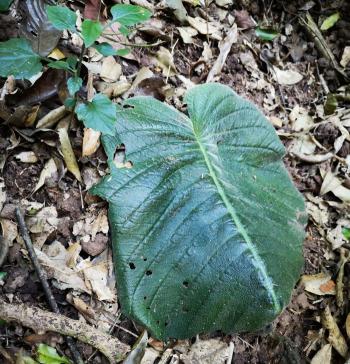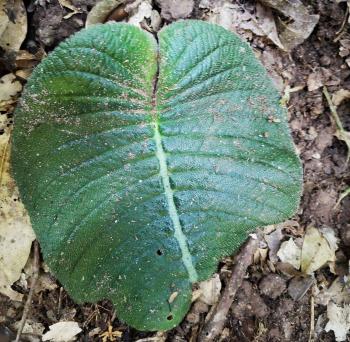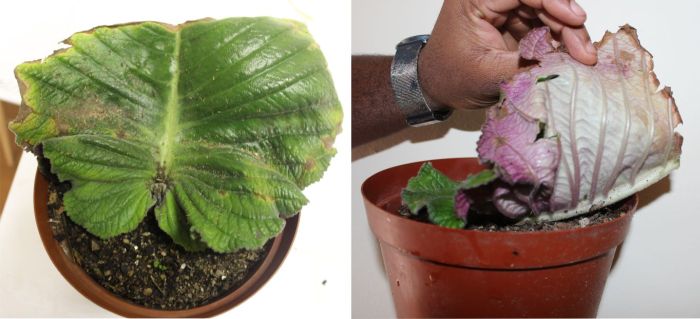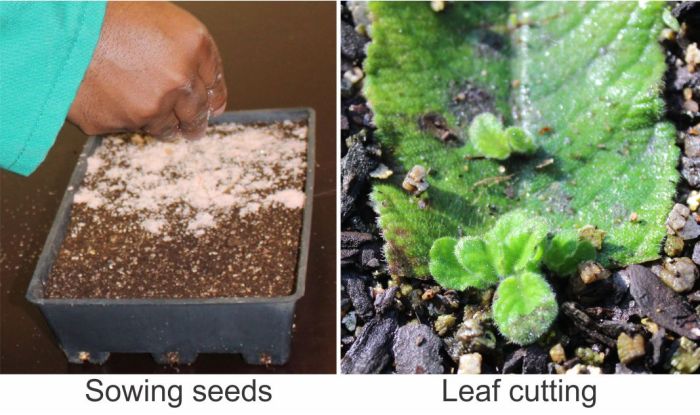Streptocarpus molweniensis
Streptocarpus molweniensis Hilliard subsp. molweniensis
Family: Gesneriaceae
Common names: Molweni streptocarpus
Introduction
Colourful, and with a long-lasting display, the Molweni streptocarpus is one of few monocarpic, one-leaved Streptocarpus with a conspicuous inflorescence of multiple flowers.

Description
Description
Streptocarpus molweniensis is a unifoliate (one leaf) streptocarpus, with a dark green, glossy leaf, reaching up to 250 mm across and 350 mm long. The upper side of the leaf feels slightly hairy when you rub your hand against it. The underside of the leaf is light green and sometimes reddish purple.

The conspicuous flower stalk is about 150–200 mm long, with the tips drooping with the weight of the flowers. The flower stalk carries an inflorescence of many flowers. The flower tubes are 18–24 mm long. This species will have multiple flowers on one stalk, however, they will only open singly or a few at a time. Flowers are pale mauve to violet and have an elongated, cylindrical tube. The fruit is a twisted, cylindrical capsule, which has a velvety feel when developing. When the fruit is ripe, it dries up and the seed pod twists open in a spiral, releasing many very fine dark seeds.

An unusual feature of this streptocarpus is that it is monocarpic (single fruiting); one cotyledon dominates and enlarges substantially, occasionally with some basal leaves, then the plant dies after flowering and setting seed.
Conservation Status
Status
Streptocarpus species are not widely distributed, they are concentrated in certain areas and they occur in very small populations, and Streptocarpus molweniensis is no exception. It is known from just 3 locations and is assessed as Vulnerable (VU), threatened mostly because of urban development.

Distribution and habitat
Distribution description
Streptocarpus molweniensis occurs in Eskotene Kloof near the Molweni River, in the northern parts of KwaZulu-Natal. It thrives in shade or dappled light, and in moist but very well-drained soils of the dolerite cliff faces. It is distributed along the mist-belt forest vegetation of an altitude ranging from 700–900 m. It will not tolerate any frost.

Derivation of name and historical aspects
History
The genus name Streptocarpus derives from the Greek streptos, meaning ‘twisted’, and karpos, ‘a fruit’, thus, referring to the twisted fruit or seed pods of this genus. This species was named molweniensis because it was discovered by Dr O.M. Hilliard within the kloof where the Molweni River flows, and she named it after the River.
Streptocarpus belongs to the Gesneriaceae, the family of the popular African violets. This is a family with over 100 genera and over 2 000 species.

Ecology
Ecology
Most of the species in the Gesneriaceae family, including Streptocarpus molweniensis, are epiphytes, i.e. plants that grow on other plants, such as trees, without deriving nourishment from them, and lithophytes, i.e. plants growing on rocky outcrops.
Streptocarpus molweniensis has attractively coloured flowers that secrete scented nectar that attracts bees, making bees one of the pollinators for this species. Streptocarpus species easily cross-pollinate within the genus, producing many hybrids. Flowers are usually produced for a month or two, and after flowering, fruits will develop. The fruits have an interesting way of unfolding, like a spiral, releasing thousands of very fine, brown seeds.
Uses
Use
Streptocarpus hybrids are very popular indoor pot plants. Very few species were used as parent plants in order to develop the hybrids available today, with really striking flower colors and forms, which make very popular indoor plants. There is an interest and a growing demand for Streptocarpus in South Africa.

Growing Streptocarpus molweniensis
Grow
All propagation is best done in spring which is the start of the growing season. Streptocarpus molweniensis can easily be grown from seed as well as cuttings, just as most species of Streptocarpus.

When germinating this species, because of its very fine seeds, mix them with white silica sand to assist with spreading the seeds evenly and to prevent sowing too densely on the tray. Use a well-drained medium that is not too coarse. A mixture of 1 part peat and 1 part sand/perlite has proven to be more effective. Cover the sown seed with a very thin layer of fine sand and keep in a warm place, away from direct sunlight.
Vegetative propagation or cuttings is another way of propagating this species. Fresh healthy leaf is sliced off the central vein, separating the leaf into 2 halves, or slice the leaf across to have multiple pieces. Place the cut pieces in the potting soil with the exposed side (cut part) of the leaf towards the soil. Keep the medium moist, not damp or wet, until the formation of shoots can be observed. Subsequently, new shoots can be observed after a 3–4 weeks, forming along the cut parts of the leaves. Once new shoots develop first true leaf, they can then be detached from the ‘parent leaf’ and be potted separately.
Better germination (seed propagation) or shoot (leaf cutting) results are often obtained if the tray is covered with a glass sheet or enclosed in a clear plastic packet, which keeps the soil surface constantly most.
Streptocarpus plants are prone to pests and diseases when they are not being treated or grown correctly. Some of the human errors in handling cultivated Streptocarpus are overwatering, underfeeding, rootbound plants and lack of good air movement/circulation. To keep Streptocarpus looking attractive, regularly remove all dead, unhealthy, dying leaves and flowers.
Caterpillars, mealy bug and fungal infection are the most troublesome pests and disease on Streptocarpus molweniensis. Pests such as caterpillars can be hand-collected or sprayed with a suitable poison. Mealy bug can be strayed with a suitable pesticide. If fungus is found on any part of the plant, treat with a suitable fungicide, improve the air circulation and take extra care not to overwater.
References
- Arnold, J. 1979. The illustrated Encyclopedia of house plants. Ward Lock, London.
- Burtt, B.L. & Hilliard, O.M. 1971. Streptocarpus, an African plant study. University of Natal Press, Pietermaritzburg.
- Dibley, R. 2008. Streptocarpus. Dibleys Nurseries, Colwyn Bay.
- Gibson, J.M. 1975. Wild flowers of Natal: coastal region. Trustees of the Natal Publishing Trust Fund, Durban.
- Pooley, E. 1998. A field guide to wild flowers Kwazulu-Natal and the eastern region. Natal Flora Publications Trust, Durban.
Credits
Mpho Mathalauga
KwaZulu-Natal National Botanical Garden
November 2020
Acknowledgements: images of Streptocarpus molweniensis in flower in habitat by Mr Paolo Candotti, from his observation on iNaturalist.
Plant Attributes:
Plant Type: Perennial
SA Distribution: KwaZulu-Natal
Soil type: Loam
Flowering season: Early Summer, Late Summer
PH:
Flower colour: Purple, Mauve/Lilac
Aspect: Shade
Gardening skill: Average
Special Features:
Horticultural zones







Rate this article
Article well written and informative
Rate this plant
Is this an interesting plant?
Login to add your Comment
Back to topNot registered yet? Click here to register.